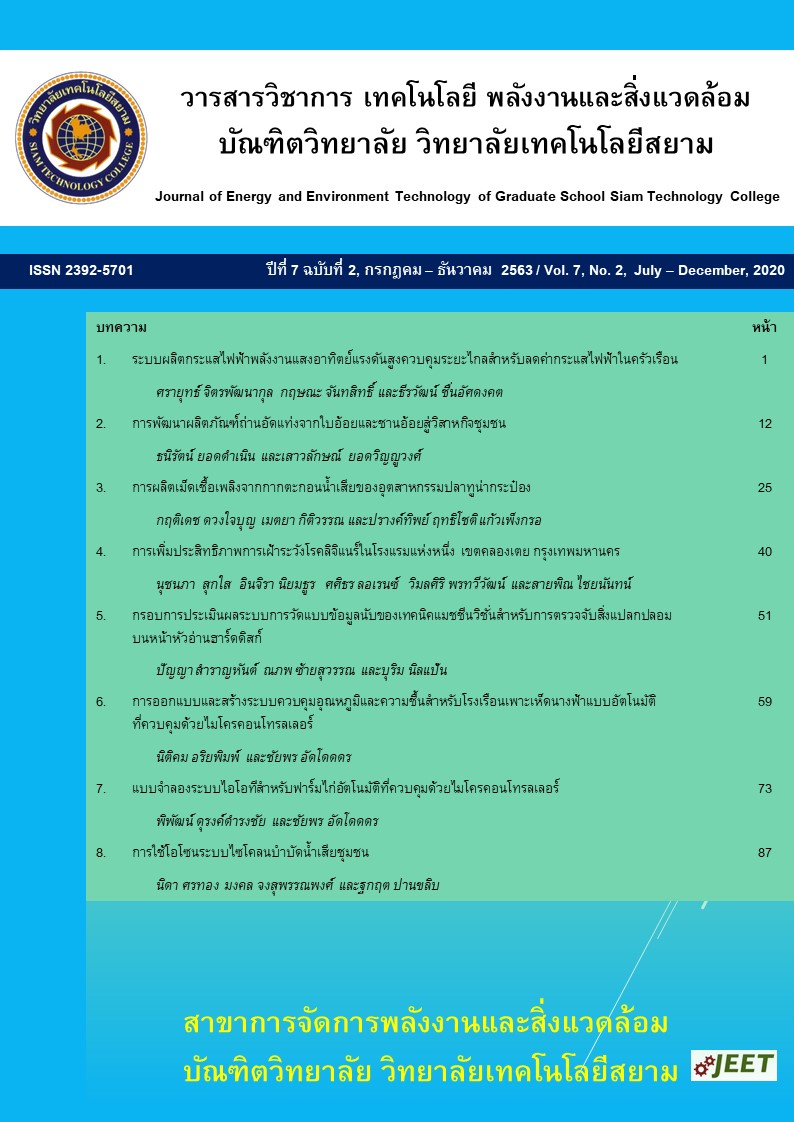Production of Fuel Pellets from Sewage Sludge of the Canned Tuna Industries
Main Article Content
Abstract
Canned tuna processing industry It is an industry that is very important in the economic development of Thailand. This is because the industry generates a large amount of income from canned tuna exports to more than 10 countries around the world. But even though the growth of the domestic canned tuna processing industry is increasing. But manufacturing processes in this industry generate a lot of solid and liquid wastes and need to be handled properly. These wastes are brought to the wastewater treatment system to treat and separate the sludge from the water. Improve water quality before it is released to the public. But the sewage sludge that is separated Currently, it can not be used to benefit. Most of them are collected and sent to an agency that receives sludge disposal. It is a cost burden which is considered the cost of production to the operator. With the cost problem arising from the remaining sewage sludge disposal mentioned above. Therefore, the concept of applied waste to energy technology (WTE) is used to solve this problem. By used the sewage sludge from the canned tuna processing industry to produce pellets as a substitute for coal in boilers. This study will focus on the physical properties, calorific heating value and finalcial return of investment cost of using the sewage sludge. The results from this study will be a guideline for the best utilization of waste. Both in terms of reduced costs in waste disposal and convert waste to energy. The results of the study showed that the fuel pellets produced from the sewage sludge had suitable properties to be used as a substitute for coal due to the relatively high carbon content and sulfur-free. Including having a good calorific heating value, 12.56 MJ / kg, can reduced total costs, 59.58% and have the following economic returns: NPV 48,328.03 baht, IRR 31.19%, B/C 144.64% and the payback period is 3.0 years.
Article Details
เนื้อหาและข่อมูลในบทความที่ลงตีพิมพ์ในวารสารวิชาการ เทคโนโลยี พลังงาน และสิ่งแวดล้อม บัณฑิตวิทยาลัย วิทยาลัยเทคโนโลยีสยาม ถือเป็นข้อคิดเห็นและความรับผิดชอบของผู้เขียนบทความโดยตรง ซึ่งกองบรรณาธิการวารสารไม่จำเป็นต้องเห็นด้วย หรือว่าร่วมรับผิดชอบใด ๆ
บทความ ข้อมูล เนื้อหา รูปภาพ ฯลฯ ที่ได้รับการตีพิมพ์ในวารสารวิชาการ เทคโนโลยี พลังงาน และสิ่งแวดล้อม บัณฑิตวิทยาลัย วิทยาลัยเทคโนโลยีสยาม ถือเป็นลิขสิทธิ์ของวารสารวิชาการ เทคโนโลยี พลังงาน และสิ่งแวดล้อม บัณฑิตวิทยาลัย วิทยาลัยเทคโนโลยีสยาม หากบุคคล หรือหน่วยงานใดต้องการนำทั้งหมด หรือส่วนหนึ่งส่วนใดไปเผยแพร่ต่อ หรือเพื่อกระทำการใด ๆ จะต้องได้รับอนุญาต เป็นลายลักษณ์อักษรจากวารสารวิชาการ เทคโนโลยี พลังงาน และสิ่งแวดล้อม บัณฑิตวิทยาลัย วิทยาลัยเทคโนโลยีสยาม เท่านั้น
References
Zhou, L., et al., Microbial community in in-situ waste sludge anaerobic digestion with alkalization for enhancement of nutrient recovery and energy generation. Bioresource Technology, 2020. 295: p. 122277.
Huang, H.-j., et al., Co-pyrolysis of sewage sludge and sawdust/rice straw for the production of biochar. Journal of Analytical and Applied Pyrolysis, 2017. 125: p. 61-68.
Kowalski, M., et al., Qualitative analysis of activated sludge using FT-IR technique. Chemical Papers, 2018. 72(11): p. 2699-2706.
Grobelak, A., et al., Sewage sludge processing and management in small and medium-sized municipal wastewater treatment plant-new technical solution. Journal of Environmental Management, 2019. 234: p. 90-96.
Hossain, N. and N.A.H. Morni, Co-pelletization of Microalgae-Sewage Sludge Blend with Sub-bituminous Coal as Solid Fuel Feedstock. BioEnergy Research, 2020. 13(2): p. 618-629.
Yilmaz, E., M. Wzorek, and S. Akçay, Co-pelletization of sewage sludge and agricultural wastes. Journal of Environmental Management, 2018. 216: p. 169-175.
Jiang, L., et al., A comparative study of biomass pellet and biomass-sludge mixed pellet: Energy input and pellet properties. Energy Conversion and Management, 2016. 126: p. 509-515.
Jiang, L., et al., Co-pelletization of sewage sludge and biomass: The density and hardness of pellet. Bioresource Technology, 2014. 166: p. 435-443.


